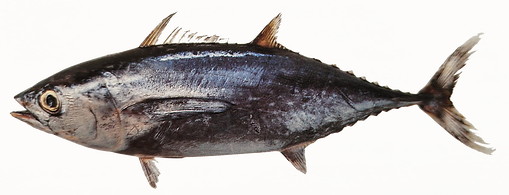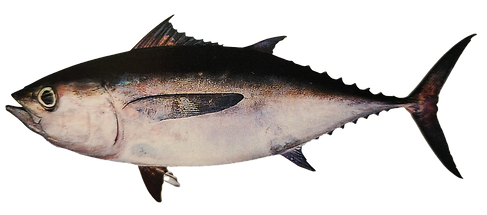

THE THUNNINI TRIBE
The tribe has 15 members. The minnows of the tribe reach only 35cm and only weigh a kilogram or two, and the whales of the tribe can grow to over 4.5 meters and weigh up to 700kg. They can burst swim up to 80km/hr and yet they can circumnavigate the globe. They are unique in so many ways. Read on to discover more.
THE REAL DEAL
Sprinters and Marathon Runners
Most people know that tuna would be in the final of the 100m sprint race at underwater Olympics, but many don't know that tuna would probably be on the winners podium of the marathon as well! This is because tuna have to swim at one body length per second to get enough oxygen in their bodies to stay alive and some tuna migrate thousands of miles during their life times.

One example of this was a tuna called Terry. This tuna was tagged and followed for his marathon run... he crossed the Pacific three times in 600 days... that's the equivalent of 956 marathons or 1.6 marathons a day!
Ram Jet Ventilators

Tuna, like lamnid sharks (think Great Whites and Mako sharks), have to keep moving to beathe. Stop swimming = no oxygen = tuna heaven. This is because tuna cannot pump water across their gills, instead they have to swim in order to ram jets of water over their gills for ventilation (gas exchange of CO2 out and O2 in). Tires me just thinking about it!

Counter Shading
Why is a tuna dark on the back and light on the belly? Actually many fish are. The phenomenon is called countershading or Thayer's Law and is both an anti-predator and predatory adaptation - just depends on who's the biggest fish!
If you are a little tuna swimming in the deep, a big tuna who may want to eat you and swimming in the shallows will struggle to see you when looking down as your back is dark just like the deep ocean is dark. However, you, little tuna, will struggle to see the big tuna when looking up as the big tuna has a white belly that blends in with the sunlight coming down from the surface. Of course it works both ways for the Great White coming up hopefully passing you to eat the big tuna!
MEET THE TRIBE
With 15 members, the Thunnini tribe could make a rugby team (my other love). Eight of the Thunnini members are known as the "true tunas" and if the Thunnini were a rugby team, they would be the eight forwards of the team because they are the biggest and the most badasses of the tunas.
THE BADASSES RAP SHEET
The Alphas: Atlantic Northern Bluefin Tuna (Thunnus thynnus)

.png)
4.53 meters
LENGTH
These giants get to over 4 meters in length and 600+ kilograms. In fact the largest ever caught was 453cm (14ft 8 inches) in length and 680kg (1,492lb) in weight. It was caught by Ken Fraser on October 26, 1979, aboard the Lady and Misty out of Port Hood, Nova Scotia, Canada.
Now when you consider tuna need to swim at one body length per second to breath, this world record tuna would have had to swim at 4.5 meters a second - that is over 16km/hour just to stay alive! So it is heavier than the average cow but it can sprint at speeds over 80km/hour.
If cut up into 15g slices for sushi I estimate it would have made over 27,200 pieces of tuna sushi! Sadly, with tuna that aren't handled well the quality can deteriorate quickly and there is chance this fish would have been fed to the cats! Indeed, on a post about the fish one contributor said "Few cans of cat food there!"

Although the Pacific Northern bluefin are smaller than their Atlantic cousins they are still giants of the sea. The largest was caught in Japan by Motohisa Sato in 1986 off Miyazaki Prefecture and weighed in at 483kg and was 2.88m long. Back in the day it was said to be worth 2 million yen and said to have fed 2400 people with tuna sashimi!
However that is nothing in comparison to what was to come in the new millennia. At 5:10am at Toyosu Fish Market tuna auction, buyer Kiyoshi Kimura bid 333.6 million yen for a 278kg Pacific Northern bluefin tuna. In US dollars at the time that was the equivalent of $3.1 million - for a single fish! Is this the real value of the fish? Not really. The first auctions of the year are always an opportunity for marketing your brand and normally a fish like this will sell for $20,000 to $30,000.
US3.1 million
DOLLARS

The Rockstars: Pacific Northern Bluefin Tuna (Thunnus orientalis)
%20Transparent%20BG.png)
The Easy Goers: Southern Bluefin Tuna (Thunnus maccoyii)
43
YEARS
The Southern bluefin may not be as big or as valuable as the other two bluefin species but what they lack in size (and at 2.5 meters they're no minnows!), they make up for in life span. The northern bluefins are much faster growing and live to about 25 to 30 years old. However in the more chilled southern ocean their southern cousins can reach over 40 years old with the oldest recorded Southern bluefin tuna reaching the ripe old age of 42!

The Romantics: Bigeye Tuna (Thunnus obesus)
With the species name obesus you could be forgiven for thinking they are the fattiest tuna, but they aren't (more on that later). It refers to their big round eyes of which they are named. Now those big eyes are not the reason for calling them the romantics - they just help them see their prey in the deep water where they spend most of their time.
They are called the romantics because they love the glistening of the full moon over the sea, so much so they rise up to the surface before, during and after the full moons - to eat of course!
Loves
THE MOONLIGHT
In Japanese Bigeye tuna are called mebachi with the 'me' meaning eye 目 and 'bachi' 鉢 means pot. So not a direct translation but they a fish with eyes the size of pots!
The James Deans: Yellowfin Tuna (Thunnus albacares)
.png)
Lives Fast
DIES YOUNG
Yellowfin are the shortest lived of the larger tunas, renowned as a fighting fish they live fast in the warmer surface waters. In Hawaii they are called Ahi, which means fire because, according to legend, these big powerful fish caused the coconut rope to create traction on the side of the canoe, making the line look like it was on fire!
Yellowfin are majority red coloured muscle called akami in Japanese. The other name is tekka, referring to the hot iron of a blacksmith, and made up of the characters for iron 鉄 and fire 火, and this power muscle is packed with the iron-containing red pigment called myoglobin that fires the furnace of the Yellowfin tuna.
The Uncanny: Albacore Tuna (Thunnus alalunga)

So why Uncanny? Well firstly they have extraordinarily long pectoral fins that often extend beyond the secondary dorsal fin - twice as long as other tuna species. Secondly they have a pinkish white coloured flesh unlike the red coloured meat we associated with other tunas. The main reason I call this tuna uncanny is that sadly this amazing fish is often put into cans, when its meat is absolutely delicious. How delicious you ask? Well, in season Albacore can have a very high fat content that resembles the most expensive belly toro of the bluefins.
Most Nutritious
DON'T CAN IT
In fact, when I was researching tuna at Tsukiji, a record bluefin tuna bought by Ishimiya was cut up and some Otoro was sent to a TV studio along with some in season Albacore. They were asked to choose which was from the Northern bluefin tuna and which was from the Albacore. Only one celebrity chose the Northern bluefin tuna correctly. The difference in price was 10,000 times so it goes to show, its not always about the price you pay. One last thing, Albacore have been said to be the most nutritious of tunas, so why can it!?
The Bladderless: Longtail Tuna (Thunnus tonngol)
The Black Sheep: Blackfin Tuna (Thunnus atlanticus)
Zero
SWIM BLADDER


The Chimera
BLACK FINLETS
Longtail tuna, also known by their Latin name Tonggol, are a small, slow growing tuna that are distributed in the continental waters of the Indian and Western Pacific Oceans. Interestingly, they are the only true tuna that doesn't have a swim bladder ( a gas filled sac in the body cavity) that acts like a buoyancy vest to help keep fish upright and buoyant in the water column.
Why the 'chimera'? Well in Japan I found a text that claims the species to have meat like a Bigeye tuna, the pectoral fin of a Yellowfin tuna, yet it has unique black finlets (small fins that stretch from the back to secondary dorsal and anal fins to the tail). It's mostly found along the east coasts of North and South America, where it's caught by sports fishers, and if commercial, it's normally salted or canned.

The Whole Family
Even though this site focusses on the trye tunas, we should take a step back for context. The tunas and their tribe the Thunnini are part of the Scombridae Family. Through this family the tunas are related to the bonitos and the mackerels that are part of their own different tribes.
On the home page I want to share some amazing things about tuna in a fun and interesting way. This site is a work in progress and more pages will be added that will give readers a deep dive into the various tuna topics. I will also be sharing my experiences with you through a blog. So let's get stuck in!
The Thunnini tribe is made of of five genera - the Allothunnus with one species (Slender tuna), the Auxis with two species (Bullet Tuna and Frigate tuna), the Euthynnus with three species (Mackerel tuna, Little tunny, and Black skipjack), the Katsuwonus with one species (Skipjack) and the Thunnus also known as the True Tunas that contains eight species. The smallest, the Blackfin tuna, the Longfin or Dogtooth tuna, the Albacore tuna, the Yellowfin tuna, the Bigeye tuna, and, finally, there are the kings - the three bluefins - one Southern bluefin tuna, and two Northern bluefin tunas - the Atlantic bluefin tuna and the Pacific bluefin tuna.

Tuna are incredible animals. Their morphology and physiology are, like most apex predators, perfectly adapated to their realm. In the future we will dive a little deeper into how they live and the biology behind it that helps keep them at the top end of the food chain.
Morphology
Physiology
Coming soon! But here you will learn about the reason their muscles recover exericise like no other, about the niche expansion theory and how their blood vessels are arranged to trap heat and super heat their muscles, how their capilliaries manifold to turbo charge their muscles etc. etc.!!